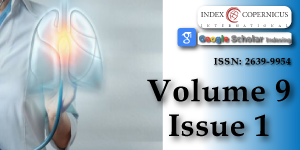Pulmonary Pleomorphic Carcinoma: A Rare Entity Revisited!
Main Article Content
Abstract
Introduction: Pleomorphic Carcinoma (PC) is a subset of poorly differentiated non–small cell lung cancer that is diagnostically challenging because it is a rare malignancy of the lung. It shows varying dual-cell components; spindle or giant cells and epithelial cells.
Method: We report a case of 68-year-old non-smoking female who presented with cough, fever, pain in the left side of chest & weight loss of recent onset and an abnormal shadow on her chest X-ray. Computed tomography of chest revealed a well defined heterogeneously enhancing cavitatory soft tissue lesion in the posterior basal segment of the left lower lobe with mediastinal lymphadenopathy.
Results: Fine needle aspiration cytology& percutaneous lung biopsy confirmed poorly differentiated malignant tumor. Patient underwent a left lower lobectomy. A diagnosis of PC was confirmed after Immunohistochemistry (IHC). Mutation analysis revealed an EGFR exon 21 mutation within the tumor cells. The patient is on Gefitinib based chemotherapy and has remained disease-free for three years post-surgery.
Conclusion: PC of the lung is a rare pathological entity. Definite diagnosis may only be made on a resected tumor along with the use of IHC. Surgical resection is the main modality of the treatment. Such rare cases should be documented to establish an optimal management plan and to provide a further insight to targeted therapy.
Article Details
Copyright (c) 2025 Deshmukh Mahesh K, et al.

This work is licensed under a Creative Commons Attribution 4.0 International License.
Chang YL, Lee YC, Shih JY, Wu CT. Pulmonary pleomorphic (spindle) cell carcinoma: peculiar clinicopathologic manifestations different from ordinary non-small cell carcinoma. Lung Cancer 2001; 34: 91–97. Available from: https://doi.org/10.1111/j.1348-0421.2008.00083.x
Kerr KM, Pelosi G, Austin JHM. World Health Organization Classification of Tumours of the Lung, Pleura, Thymus and Heart. Lyon: IARC Press; 2017:88–90.
Rossi G, Cavazza A, Sturm N, Migaldi M, Facciolongo N, Longo L, Maiorana A, Brambilla E. Pulmonary carcinomas with pleomorphic, sarcomatoid, or sarcomatous elements: a clinicopathologic and immunohistochemical study of 75 cases. Am J Surg Pathol. 2003;27(3):311-24. Available from: https://doi.org/10.1097/00000478-200303000-00004
Kaira K, Horie Y, Ayabe E, Murakami H, Takahashi T, Tsuya A, Nakamura Y, Naito T, Endo M, Kondo H, Nakajima T, Yamamoto N. Pulmonary pleomorphic carcinoma: a clinicopathological study including EGFR mutation analysis. J Thorac Oncol. 2010;5(4):460-5. Available from: https://doi.org/10.1097/jto.0b013e3181ce3e3c
Zhang X, Wang Y, Zhao L, Jing H, Sang S, Du J. Pulmonary pleomorphic carcinoma: A case report and review of the literature. Medicine (Baltimore). 2017;96(29):e7465. Available from: https://doi.org/10.1097/md.0000000000007465
Kawamura A, Tanaka Y, Inoue Y, Tsuchida T, Katsumata M, Karayama M, et al. EGFR-mutated, metastatic pulmonary pleomorphic carcinoma successfully treated with afatinib, Current Problems in Cancer: Case Reports. 2022:6:100160. Available from: https://doi.org/10.1016/j.cpccr.2022.100160
Jia X, Chen G. EGFR and KRAS mutations in pulmonary pleomorphic carcinoma and their correlation with clinicopathologic features. Contemp Oncol (Pozn). 2015;19(1):22-7. Available from: https://doi.org/10.5114/wo.2014.43491





